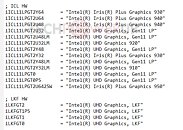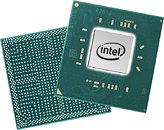
Several Gen11 GPU Variants Referenced in Latest Intel Drivers
The latest version of Intel Graphics drivers which introduce the company's latest UWP-based Graphics Command Center app, hide another secret in their INF. The file has pointers to dozens of variants and implementations of the company's next-generation Gen11 integrated graphics architecture, which we detailed in a recent article. Intel will implement Gen11 on two key processor microarchitectures, "Ice Lake" and "Lakefield," although later down the line, the graphics technology could trickle down to low-power Pentium Silver and Celeron SoC lines, too, with chips based on the "Elkhart Lake" silicon.
There are 13 variants of Gen11 on "Ice Lake," carved using execution unit (EU) count, and LP (low-power) aggressive power management. The mainstream desktop processors based on "Ice Lake," which are least restrained in power-management, get the most powerful variants of Gen11 under the Iris Plus brand. Iris Plus Graphics 950 is the most powerful implementation, with all 64 EUs enabled, and the highest GPU clock speeds. This variant could feature on Core i7 and Core i9 brands derived from "Ice Lake." Next up, is the Iris Plus Graphics 940, with the same EU count, but likely lower clock speeds, which could feature across the vast lineup of Core i5 SKUs. The Iris Plus 930 comes in two trims based on EU count, of 64 and 48, and could likely be spread across the Core i3 lineup. Lastly, there's the Iris Plus 920 with 32 EUs, which could be found in Pentium Gold SKUs. There are various SKUs branded "UHD Graphics Gen11 LP," with EU counts ranging from 32 to 64.
There are 13 variants of Gen11 on "Ice Lake," carved using execution unit (EU) count, and LP (low-power) aggressive power management. The mainstream desktop processors based on "Ice Lake," which are least restrained in power-management, get the most powerful variants of Gen11 under the Iris Plus brand. Iris Plus Graphics 950 is the most powerful implementation, with all 64 EUs enabled, and the highest GPU clock speeds. This variant could feature on Core i7 and Core i9 brands derived from "Ice Lake." Next up, is the Iris Plus Graphics 940, with the same EU count, but likely lower clock speeds, which could feature across the vast lineup of Core i5 SKUs. The Iris Plus 930 comes in two trims based on EU count, of 64 and 48, and could likely be spread across the Core i3 lineup. Lastly, there's the Iris Plus 920 with 32 EUs, which could be found in Pentium Gold SKUs. There are various SKUs branded "UHD Graphics Gen11 LP," with EU counts ranging from 32 to 64.












